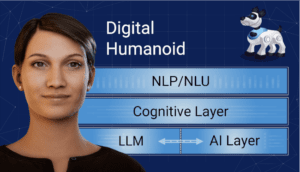The following is a guest article by Steve Lazer, Global Healthcare and Life Sciences CTO at Dell Technologies
The purpose of this paper is to explore the role of digital entities in healthcare. Specifically, we will examine their applications in patient care, medical education, and mental health support. Furthermore, we will discuss the potential benefits and challenges associated with the integration of digital entities whether humanoid or not into the healthcare system.
Staffing shortages have become a critical issue in the healthcare industry, impacting patient care and overall quality of service. In this article, we will explore the role of digital entities in mitigating these shortages and making healthcare more patient-centric. Specifically, we will examine their applications in patient care, medical education, and mental health support. Furthermore, we will discuss the potential benefits and challenges associated with integrating digital entities, whether humanoid or not, into the healthcare system.
What is a Digital Entity?
A digital entity is an electronic representation of an object, person, or concept that is fully integrated with conversational artificial intelligence – creating a human-like interface to simplify engagement and communication. The form of the digital entity will be based on the relevant use case, spanning humanoid, animal- or other life-form-based representation (e.g. dogs), or a cartoon entity. In this article, we will focus on digital human entities.
Digital humans are computer-generated entities that resemble human beings in appearance, behavior, and communication abilities. They are designed to interact with humans, and/or perform certain actions, using natural language processing, facial recognition, and other AI techniques. These entities can exhibit lifelike features, including facial expressions, gestures, and even emotional responses, all within the confines of a digital environment.
The Anatomy of a Digital Human
Similar to a true human, digital humans have anatomy. A Digital Human consists of a combination of a number of technologies. The entity includes:
- The Representation: A digital representation of the entity you want to use as the “face” of the entity, this can be created from a representation of a real human, a caricature of a human, or other concepts. The quality of this representation is critical to the success of the project.
- Natural Language Processing (NLP) or Natural Language Understanding (NLU): Natural language processing – understanding to interpret the information from the engagement. This includes:
- Speech Detection
- Speech-to-Text Translation
- Language Recognition and Detection
- Cognitive Services: Cognitive services are used for creating personalization of communication including the following functions:
- Language Translation
- Speech Synthesis
- Voice Customization
- Speech Prosody & Pitch
- Nomenclature and Specialized Pronunciation
- Artificial Intelligence: The artificial intelligence layer, whether Generative or Extractive or other forms provides:
- Contextual Conversation Response
- Context Recognition
- In the case of Generative – Content Creation
- Large Language Models (LLMs): Large language models will use various algorithms to accomplish the following:
- Support for Structured and Unstructured Data Ingestion
- Scale Out Capacity and Growth
- API Integration
- Unsupervised Learning as Necessary

Why Use a Digital Human?
Many healthcare and life sciences organizations are already using chatbots today. From customer support to virtual assistants and education and training, these technologies have become increasingly ubiquitous. Over time, chatbots have continued to evolve with advancements in artificial intelligence, natural language processing, and machine learning. Modern chatbots leverage these technologies to provide more sophisticated and context-aware conversations, enhancing user experiences across a wide range of applications and platforms.
However, “digital humans” are taking this concept one step further – adding generative AI capabilities, sentiment, and non-verbal capabilities for more human-like interactions. As is frequently noted in communication research, approximately 90% of communication is nonverbal. Albert Mehrabian, a researcher of body language, first broke down the components of a face-to-face conversation. He found that communication is 55% nonverbal, 38% vocal (tonality), and only 7% is the literal meaning of the words. This is where the idea that most of the communication is nonverbal originated. Research has indicated people can better relate to digital humans that have a more realistic appearance including nonverbal cues such as facial gestures like winking or nodding in addition to things like frowning and sharing sentiment.
Digital humans must be realistic in their caricature and authentic enough to convince other humans to interact with them. They can be in any form, including humanoid, animalistic, avatar, or as a cartoon. In whatever way they are represented, they must be realistic and believable within the context of their role. In order to do so, digital humans must be able to show relevant emotion and sentiment to be credible.
Potential Use Cases for Digital Humans in Healthcare
The use cases for a digital human are nearly limitless within the healthcare realm. As with the use of any form of AI, the most prudent approach to implementation is to start with a small non-mission-critical pilot. As confidence and comfort grow within the AI-based digital human, use cases can expand into a plethora of different applications. These include:
Translation Services
When encountering a patient, the ability to engage and interact in the patient’s own language and present a culturally appropriate representation of the language utilized if desired. Please note computer vision-based sign language is not yet available but coming forward on the near-term horizon. For patients not able to speak, textural communication in the desired language is possible.
Patient Wayfinding
By presenting a digital human on a mobile device such as a cell phone or other GPS-enabled device and allowing the digital human to escort the patient to the proper location within the healthcare facility. This approach minimizes stress and works to keep patients headed in the right direction and on time for their appointments.
Ambulatory Patient Intake
Automating the intake process and reserving staff resources for more valuable tasks. Drawing on the EMR for patient history and medication information.
Patient Discharge Instructions
Delivering consistent discharge instructions based upon EMR information and allowing for both the documentation of the questions and the actual aftercare response. Improving the overall discharge process by not requiring staff to be available until transport is necessary.
Aftercare Follow-Up/Virtual Physical Therapy
Aftercare and follow-up for a patient are critical in providing the successful outcome of any procedure or treatment. Utilizing a digital human to engage and support them from wherever they are will go a long way to aftercare compliance. This will minimize the amount of bounce back that is often experienced with patients that do not follow up appropriately. The ability to provide virtual physical therapy with a digital human leading the patient to the appropriate movements and steps for their recovery will reduce the overall cost of care as well as the accessibility of care for patients who may not be able to travel easily.
Virtual Caregiver
Supporting remote patient care delivery and chronic care management by developing a personal interaction with the digital human encouraging patients to follow up on their aftercare.
Behavioral Health/Elder Companionship
Creating a relationship with the digital human to minimize loneliness and helps support patients potentially experiencing depression based upon their isolation.
Medication Adherence
Combining the digital human together with computer vision to monitor and document medication adherence. The digital human can provide coaching and encouragement while utilizing computer vision to support the documentation aspect of medication adherence, thereby minimizing patient return to the healthcare system.
Patient Education and Procedural Understanding
Utilizing a digital human to support the education of patients helping them understand the processes and procedures they will go through, goes a long way to minimizing stress and reducing trepidation for the patient and patient family. Digital entities can help remove the mystery and fear many patients experience because they don’t understand what is about to happen.
Wellness Coaching
Utilizing digital coaches can offer regular and continuous reinforcement to encourage patients in leading healthier lifestyles and maintaining their wellness, helping to keep them out of the hospital and away from high-cost care.
Service Desk Support
Digital humans can serve in areas beyond purely clinical interactions. With the ability to review past service tickets, identify patterns, and offer solutions while demonstrating empathy and sincerity in addressing challenges or problems, it can be deployed very effectively as self-service tools at service desks.
Clinician Education
Digital humans can provide convenient and accessible clinician education by demonstrating proper processes and procedures, allowing clinicians to receive training remotely and at their own convenience instead of relying on in-person trainers.
While we don’t expect digital humans to eliminate healthcare jobs or staff positions, they can augment this workforce by taking many of the routine and repetitive tasks off their plate, which, in turn, can help alleviate widespread burnout amongst clinical professionals.
Leveraging Digital Humans to Make Healthcare Technology More Patient-Centric
In conclusion, digital humans can play a significant role in alleviating current staffing shortages and challenges in delivering high-quality care. As we see the role of digital humans continuing to grow, we at Dell Technologies believe that digital humans and in-silico development will merge to form a true clinical digital twin – both visually and biologically.
Forward-thinking organizations are beginning to experiment with utilizing digital humans as a staffing augmentation service that can address staffing shortages or perform undesirable tasks. As the field of digital healthcare continues to evolve, the collaboration between the clinical workforce and digital humans holds immense potential for a patient-centric and technologically advanced hospital of the future.
 About Steve Lazer
About Steve Lazer
Steve is the Global Healthcare and Life Sciences CTO for Dell Technologies. He brings robust Health IT competencies and management strategies to healthcare organizations ensuring successful Healthcare IT solution delivery. He drives technical strategy and solutions development for Healthcare and ISV technical relationships including joint solutions R&D, technical advisory, and technical escalation processes. Steve is part of one of the strongest healthcare practices in the technology industry with a heritage of more than 30 years building solutions around the globe with clinical ISV partners and providing essential technology infrastructure to hospitals of all sizes.
Dell Technologies is a proud sponsor of Healthcare Scene.













